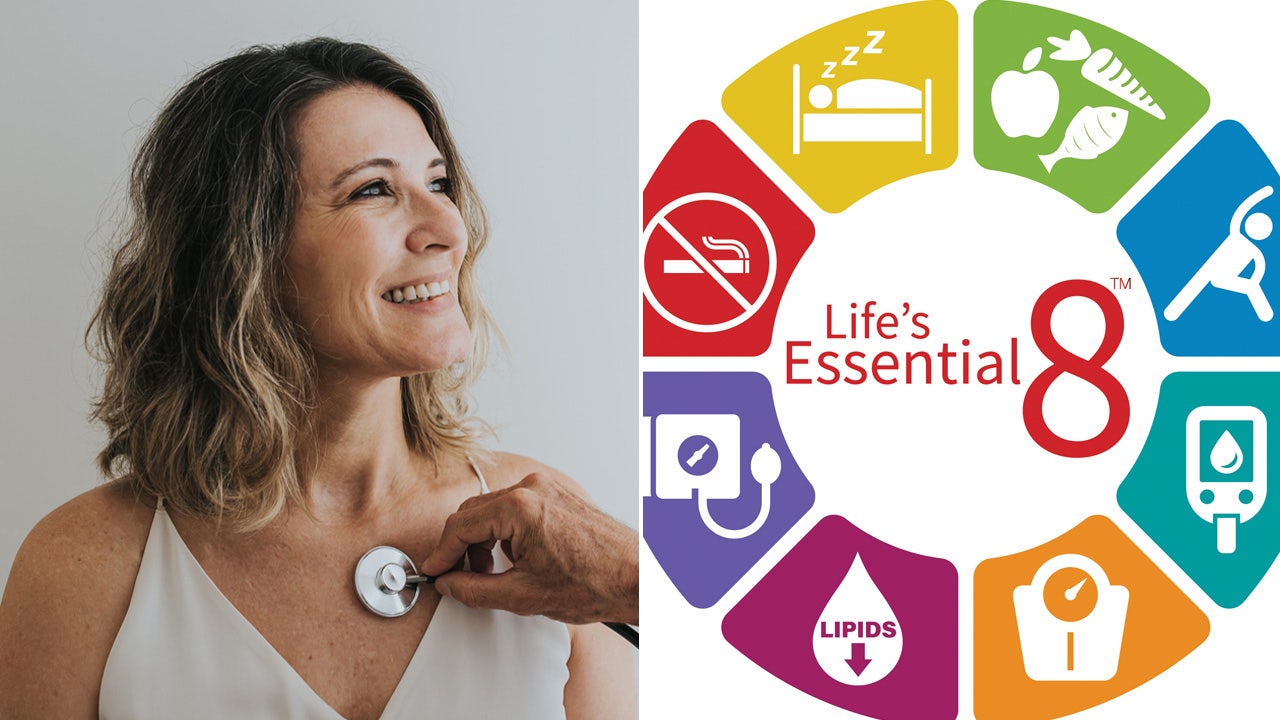Health
Want to live longer? Follow 8 heart-healthy habits, says the American Heart Association

Making several specific lifestyle changes could slow biological aging by six years, according to the American Heart Association (AHA).
A new study from the organization has found that improved heart health is key to helping to slow down the aging process, which in turn reduces the risk of cardiovascular disease and other medical issues.
The key is to incorporate “Life’s Essential 8,” which the AHA defines as “the key measures for improving and maintaining cardiovascular health.”
PIG HEART RECIPIENT’S ‘LAST WISH’ WAS TO HELP DOCTORS LEARN FROM PROCEDURE, DYING MAN SAID: ‘WE WILL MISS HIM’
The details of the findings will be presented at the AHA’s Scientific Sessions 2023 from Nov. 11-13 in Philadelphia.
Nour Makarem, PhD, an assistant professor of epidemiology at the Mailman School of Public Health at Columbia University Irving Medical Center in New York City, was the senior study author. (Columbia University Irving Medical Center)
“Improving heart health through healthy lifestyle changes does not just lower the risk of developing cardiovascular disease, but can also slow down the rate of biological aging, which can increase the number of years of life lived in good health,” said study senior author Nour Makarem, PhD, an assistant professor of epidemiology at the Mailman School of Public Health at Columbia University Irving Medical Center in New York City, in a statement to Fox News Digital.
Dr. Bradley Serwer, a Maryland-based cardiologist and chief medical officer at VitalSolution, a company that offers cardiovascular and anesthesiology services to hospitals, was not involved in the AHA’s study, but shared his findings on the highlights that have been released.

Making several specific lifestyle changes could slow biological aging by six years, according to the American Heart Association (AHA). (iStock/American Heart Association)
“This is not surprising data, as those who focus on health tend to do well clinically,” he told Fox News Digital.
“There are many health benefits, beyond coronary artery disease, to following a healthy lifestyle.”
Chronological vs. phenotypic age
While chronological age is based strictly on calendar years, the AHA tracks phenotypic age, which takes into account both actual age and blood markers that measure things like metabolism, inflammation and organ function, according to a press release from the AHA.

The American Heart Association’s Life’s Essential 8™ image is a wheel shape with 8 wedges representing the 8 elements essential for cardiovascular health. (American Heart Association)
“Phenotypic age is a practical tool to assess our body’s biological aging process and a strong predictor of future risk of disease and death,” said Makarem.
“We observed a dose-response relationship, meaning that as heart health improves, biological aging slows down.”
“Any progress toward improving heart health is clinically meaningful and promotes healthy longevity.”
Even gradual improvements in lifestyle behaviors can be beneficial, the researcher added.
“Any progress toward improving heart health is clinically meaningful and promotes healthy longevity,” she told Fox News Digital.
WANT TO AVOID A HEART ATTACK? THESE ARE THE BEST AND WORST FOODS, ACCORDING TO CARDIOLOGISTS
Cardiologist Dr. Ernst von Schwarz, who practices in Culver City, California, was not involved in the study but shared his thoughts on longevity with Fox News Digital.
“Biological aging [refers to] the continuation of the natural life cycle of cells or organisms, which follows a biologic clock that directs the processes of growth, repair and senescence (cellular aging) until apoptosis or necrosis leads to death,” he said.

Those who scored high for heart health had a younger physiological age; the opposite was true for those with poor heart health. (iStock)
In the study, researchers calculated the difference between actual and biological age for over 6,500 adults who participated in the National Health and Nutrition Examination Survey (NHANES) between 2015 and 2018.
The participants, who averaged 47 years of age, were 50% male and 50% female.
ASK A DOC: ‘HOW CAN I PREVENT HIGH CHOLESTEROL?’
Those who scored high for heart health had a younger physiological age; the opposite was true for those with poor heart health.
Per an example cited in the release, the average actual age of those with high cardiovascular health was 41, while their average biological age was 36.

Following a healthy diet is one of the “Essential 8” habits the AHA recommends for an optimal heart health score. (iStock)
For those with low cardiovascular health, the average actual age was 53 — compared to an average biological age of 57.
One limitation of the study is that the participants’ heart health markers were evaluated at only one point in time, the AHA noted, which means any later changes were not taken into account.
8 key factors for optimal heart health
The AHA calculates heart health based on an individual’s score for what it calls “Life’s Essential 8.”
Those who score high in those eight areas are, on average, six years younger biologically than their actual age.
WANT A MORE ACCURATE BLOOD PRESSURE READING? TRY LYING DOWN WHEN IT’S TAKEN, NEW STUDY SUGGESTS
The eight lifestyle behaviors for optimal heart health are the following:
- Following a healthy sleep schedule
- Not smoking
- Getting regular physical activity
- Adhering to a healthy diet
- Maintaining a healthy body weight
- Maintaining healthy blood glucose levels
- Maintaining healthy cholesterol levels
- Maintaining healthy blood pressure

Maintaining healthy blood pressure, blood glucose and cholesterol are key to improving heart health and longevity, experts say. (iStock)
After an evaluation for all eight markers, individuals received a score of high, moderate or low heart health, per the AHA.
“We still need to review the study for more details, but this reinforces that healthy diet, regular exercise, not smoking, and watching your cholesterol, blood sugar and blood pressure will make you live longer and better,” Serwer said.
“Everyone wants to live longer, yet more importantly, we want to live healthier longer, so we can really enjoy a good quality of life for as many years as possible.”
“The Essential 8 as recommended by the American Heart Association addresses risk factors that can be manipulated by applying medical recommendations in addition to self-management,” noted von Schwartz.
“Besides these eight, social and spiritual fulfillment is as important to achieve longevity,” he added.
CLICK HERE TO SIGN UP FOR OUR HEALTH NEWSLETTER
“Advances in biotechnology and anti-aging research have helped to discover certain biochemical steps and mediators that lead to and determine senescence (cellular deterioration),” von Schwarz told Fox News Digital.
“Knowing these facts enables us to interfere by using senolytic drugs and mechanisms to delay or even inhibit these processes, as we are doing in clinical studies right now.”

Getting regular physical activity is one of the “Essential 8” habits for optimal heart health. (iStock)
“These findings help us understand the link between chronological age and biological age and how following healthy lifestyle habits can help us live longer,” said Donald M. Lloyd-Jones, M.D., chair of the writing group for Life’s Essential 8 and a past volunteer president of the AHA, in the release.
“Everyone wants to live longer, yet more importantly, we want to live healthier longer, so we can really enjoy a good quality of life for as many years as possible.”
Fox News Digital reached out to the American Heart Association for additional comments on the study findings.
Founded in 1924 and headquartered in Dallas, Texas, AHA is the world’s leading nonprofit organization dedicated to fighting heart disease and stroke.
For more Health articles, visit www.foxnews.com/health.

Health
Elderberry Boosts Weight Loss and Improves Blood Sugar, New Study Shows

Sign Up
Create a free account to access exclusive content, play games, solve puzzles, test your pop-culture knowledge and receive special offers.
Already have an account? Login
Use left and right arrow keys to navigate between menu items.
Use escape to exit the menu.
Health
Chicago's Lincoln Park Zoo loses flamingo, seal to bird flu

The Avian Influenza has claimed the lives of a Harbor Seal and a Chilean Flamingo at Chicago’s Lincoln Park Zoo.
The zoo announced they received results that confirmed the highly pathogenic Avian Influenza was the cause of Teal, a Chilean Flamingo, and Slater, a Harbor Seal’s death.
“This is sad news for wildlife and for the zoo team. Not only are we facing the first known cases of HPAI in animals in our care, but we’ve lost two amazing animals,” said Director of Veterinary Services Lester E. Fisher and Dr. Kathryn Gamble in a statement. “While highly pathogenic avian influenza is a naturally occurring virus in free-ranging waterfowl, more mammal species have been reported to be susceptible to HPAI since 2022.”
ONE STATE LEADS COUNTRY IN HUMAN BIRD FLU WITH NEARLY 40 CONFIRMED CASES
The zoo announced they received results that confirmed the highly pathogenic Avian Influenza was the cause of Teal, a Chilean Flamingo, and Slater, a Harbor Seal’s death. (Lincoln Park Zoo)
The zoo was unable to confirm the source of the exposure, but the Centers for Disease Control say that HPAI is spread through saliva, nasal secretion and the feces of infected birds.
They did say that zoo visitors are not at risk of contracting the disease from the animals at Lincoln Park zoo.
“Because highly pathogenic avian influenza is spread by free-ranging birds, it is no riskier to visit Lincoln Park Zoo than to enjoy a walk outdoors,” said President & CEO and ornithologist Megan Ross. “The zoo remains a safe place to connect with the animals in our care.”
BIRD FLU LEADS TO SEVERE HUMAN ILLNESS AND STATE OF EMERGENCY; EXPERTS DISCUSS RISK

The zoo announced they received results that confirmed the highly pathogenic Avian Influenza was the cause of Teal, a Chilean Flamingo and Slater, a Harbor Seal’s death. (Lincoln Park Zoo)
The zoo has been monitoring HPAI, so there is a response plan in place. The plan addresses staff and animals. It includes personal protective equipment and removing cross contamination between species while monitoring individual animal behavior, according to a statement by the zoo. They have also closed the McCormick Bird House and will be closed until further notice.

The zoo announced they received results that confirmed the highly pathogenic Avian Influenza was the cause of Teal, a Chilean Flamingo and Slater, a Harbor Seal’s death. (Lincoln Park Zoo)
The zoo also said in their statement that it’s important to keep personal pets indoors and away from wildlife.
“Sharing this news of highly pathogenic avian influenza in the area is important for our community at large,” said Director of the Urban Wildlife Institute Seth Magle. “To protect yourself, do not handle wildlife. Additionally, keep your pets safe by keeping cats indoors and dogs on a leash away from wildlife.”
Health
Insulin Prices Dropped. But Some Poor Patients Are Paying More.

Maricruz Salgado was bringing her diabetes under control. Thanks to a federal program that allowed health clinics that serve poor people to buy drugs at steeply discounted prices, she was able to pay less than $75 for all five of her diabetes medications every three months.
But in July, the cost of three of those drugs soared. Ms. Salgado, who does not have health insurance, suddenly faced costs of hundreds of dollars per month. She could not afford it.
Her doctor switched her to cheaper medicines. Within days of taking one of them, she experienced dizzy spells so severe that she said could barely keep up with her hectic daily schedule as a phlebotomist and an in-home caregiver. By the time she returned to the doctor in September, her blood sugar levels had ticked up.
“We were in a good place,” said Dr. Wesley Gibbert, who treats Ms. Salgado at Erie Family Health Centers, a network of clinics in Chicago that serves patients regardless of their ability to pay. “And then all the medicines had to change.”
The price hikes at the clinic happened for a reason that is symptomatic of the tangled web of federal policies that regulate drug pricing. In 2024, drug makers lowered the sticker price of dozens of common medications, which allowed them to avoid massive penalties imposed by the American Rescue Plan, the Covid relief package passed three years earlier. But that change backfired for low-income people like Ms. Salgado.
The decision to make these medications more affordable for large swaths of patients has quietly created another problem: a severe financial hit to the clinics that are tasked by the federal government with caring for the country’s poorest people. These nonprofit clinics operate in every state and serve nearly 32.5 million people, or about 10 percent of the country’s population.
“It’s the law of unintended consequences,” said Beth Powell, the director of pharmacy at The Centers, which operates five community health clinics in the Cleveland area. Ms. Powell said that while many consumers benefited from the companies’ decision to lower prices, “for our folks, that is not the case.”
More than 1,000 community health clinics around the country rely on a decades-old federal program that requires drug companies to offer them deep discounts.
Under the 340B program, as it is called, companies typically sell their brand-name drugs to clinics at a discount, at 23 percent or more off the list price. The same discount scheme applies to state Medicaid plans. But if a company raises a drug’s list price above the rate of inflation, a penalty kicks in, forcing it to offer even deeper discounts to the clinics.
For years, that meant that every time a company raised a drug’s list price above inflation, community clinics paid less for it. Many drugs, including insulin, essentially became free.
But the American Rescue Plan made a major change that hit drug companies with even larger penalties for raising prices. In January 2024, companies that continued to raise a drug’s price would have to pay state Medicaid plans every time those drugs were used, potentially costing the industry billions of dollars.
“That was a bridge too far” for the companies, said Antonio Ciaccia, a drug-pricing researcher who advises state governments and employers.
Manufacturers lowered the price of at least 77 drugs in 2023 and 2024, according to an analysis by a nonprofit that Mr. Ciaccia leads. The list includes widely used asthma drugs like Advair and Symbicort, as well as diabetes treatments like Victoza, which Ms. Salgado used before the change.
Once the pharmaceutical companies lowered their list prices, the inflation penalties evaporated. That meant community clinics had to start paying the usual discounts of 23 percent or more off the list price — far more than the pennies they used to pay.
“Unfortunately, the complexities of the U.S. health care system can reduce access and affordability for many,” Jamie Bennett, a spokeswoman for Novo Nordisk, which makes Victoza, said in a statement. “Even when we lower our prices, too often people don’t receive the savings — this is a problem.” She said the company also has patient assistance programs to make its products more affordable.
David Bowman, a spokesman for the Health Resources and Services Administration, which oversees the 340B discounts, did not respond to questions about how community health clinics were affected by the lowered drug prices. He said that other recent policies, including directing Medicare to negotiate the price of drugs, had lowered drug costs for low-income patients.
Because of a six-month lag in the way that 340B discounts work, clinics were hit by the change last July. Some clinics began calling patients before their prescriptions expired, offering to switch them to less expensive medicines even though they sometimes had more serious side effects. Others decided to cover the higher out-of-pocket costs, which required dipping into already scarce reserves.
Ms. Salgado said a nurse from Erie called over the summer to tell her about the pricing changes. Until then, she had paid about $15 for a three-month supply of Victoza, which is injected daily to keep blood sugar down. After July, the cost rose to more than $300.
After a few weeks, Ms. Salgado adjusted to the replacement, Byetta, and her dizziness subsided. But the drug must be injected twice a day instead of once. And Ms. Salgado must now use a special pharmacy 20 minutes from her house to qualify for the federal discount on the two insulin drugs she was switched to, the result of increasingly strict rules that companies are imposing on health clinics.
Ms. Salgado, who is 39, said she is determined to avoid the fate of her mother, who died of diabetes complications at 54. But keeping up with frequent pharmacy visits and medication changes is tough. “Sometimes it does get to a point where it’s like, I just don’t want to do this anymore,” she said.
The changes are also making it harder for community clinics to offer other services.
Under the 340B program, clinics buy the discounted drugs on behalf of their patients. When those patients have insurance, the clinics can then bill insurers for the regular, higher price, pocketing the difference. But now that spread — the difference between how much they pay for the drug and what insurance will cover — has dwindled. That has left clinics with less money to spend on services that are not otherwise covered by government grants or insurance, such as helping patients find housing.
At Valley View Health Center, a network of clinics that serves patients in rural Washington, the 340B money once financed a mental health program that employed eight therapists. In September, the clinic halted the program, laying off the therapists.
“It was such an abrupt change for us that it has definitely affected our ability to care for our patients the way that we needed to,” said Gaelon Spradley, the clinic’s chief executive.
Some patients who have seen costs go up have qualified for patient-assistance programs offered by drug makers. That was the case for Lorena Sarmiento, another patient at Erie Health who uses Lantus, an insulin pen. Last fall, after the 340B discount changed, she was quoted $490 at her pharmacy — the retail price for a box of insulin pens. Erie Health sent her to another pharmacy, which helped her sign up for a manufacturer’s coupon that lowered her cost to $35 per month.
Doctors and pharmacists at several health clinics said such drug-company assistance programs can be hit or miss. Sometimes they last for a limited time or require that a patient reapply regularly. Patients often have to be legal residents of the United States or have a fixed address.
“It’s a lengthy process, and it’s a lot of hoop-jumping,” said Michael Lin, the chief of pharmacy operations at Family Health Centers in Louisville, Kentucky.
Ms. Sarmiento and her husband, Luis, spend about $500 per month on her medical needs, including special food, medications and a glucose monitor. They are no longer facing the highest insulin price, but their costs are still 10 times what they were just a few months ago, when they spent about $10 on three months’ worth of insulin.
Mr. Sarmiento said he tries not to complain. “You always have to look on the good side,” he said. “But lately, that’s been hard.”
-
/cdn.vox-cdn.com/uploads/chorus_asset/file/25822586/STK169_ZUCKERBERG_MAGA_STKS491_CVIRGINIA_A.jpg)
/cdn.vox-cdn.com/uploads/chorus_asset/file/25822586/STK169_ZUCKERBERG_MAGA_STKS491_CVIRGINIA_A.jpg) Technology1 week ago
Technology1 week agoMeta is highlighting a splintering global approach to online speech
-

 Science5 days ago
Science5 days agoMetro will offer free rides in L.A. through Sunday due to fires
-
/cdn.vox-cdn.com/uploads/chorus_asset/file/25821992/videoframe_720397.png)
/cdn.vox-cdn.com/uploads/chorus_asset/file/25821992/videoframe_720397.png) Technology1 week ago
Technology1 week agoLas Vegas police release ChatGPT logs from the suspect in the Cybertruck explosion
-

 News1 week ago
News1 week agoPhotos: Pacific Palisades Wildfire Engulfs Homes in an L.A. Neighborhood
-

 Education1 week ago
Education1 week agoFour Fraternity Members Charged After a Pledge Is Set on Fire
-

 Business1 week ago
Business1 week agoMeta Drops Rules Protecting LGBTQ Community as Part of Content Moderation Overhaul
-

 Politics1 week ago
Politics1 week agoTrump trolls Canada again, shares map with country as part of US: 'Oh Canada!'
-
/cdn.vox-cdn.com/uploads/chorus_asset/file/23935558/acastro_STK103__01.jpg)
/cdn.vox-cdn.com/uploads/chorus_asset/file/23935558/acastro_STK103__01.jpg) Technology5 days ago
Technology5 days agoAmazon Prime will shut down its clothing try-on program















